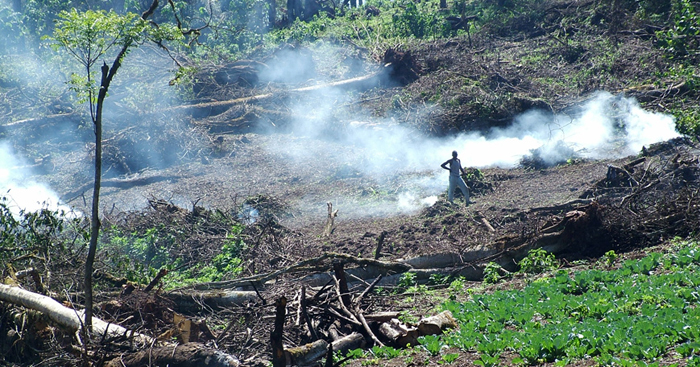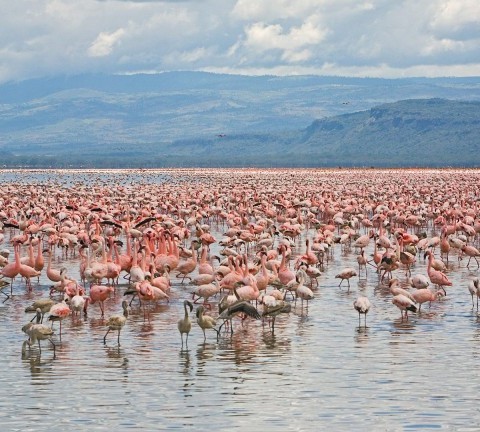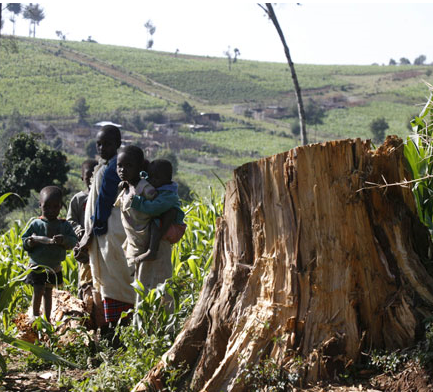 Photo courtesy of United Nations Environment Programme.
Photo courtesy of United Nations Environment Programme.
Mau Forest Complex forms the largest closed-canopy forest ecosystem of Kenya. It is the single most important water catchment in the Rift Valley and western Kenya. As Dave pointed out in his blog article last year, the ecosystem services provided by Mau Forest support key economic sectors, including energy, tourism, agriculture and water supply – it's particularly important for two of the three largest foreign currency earners: tea and tourism. As the source of 12 rivers, the forest's ability to generate rain and to store water is an ecosystem service worth huge sums to activities downstream.
As officials and ministers gather at Nagoya in Japan for a major conference on the UN Convention on Biodiversity this week, new research by the Kenya Forest Research Institute (KEFRI) and the United Nations Environment Programme (UNEP) estimates the economic benefit of Mau Forest to be more than $1.3bn per year. But how did they calculate this figure?
 Estimating an economic value for the environment is notoriously difficult. Just last year UNEP’s value for Mau Forest was much lower at £166m per year. Details of their methods are not available, but the total economic value should be a combination of ‘use value’ (direct marketable use e.g. timber and fruits; direct non-marketable use e.g. scenery and wildlife; indirect use e.g. ecosystem function and climate mitigation; and option value) and ‘non-use value’ (bequest and existence).
Estimating an economic value for the environment is notoriously difficult. Just last year UNEP’s value for Mau Forest was much lower at £166m per year. Details of their methods are not available, but the total economic value should be a combination of ‘use value’ (direct marketable use e.g. timber and fruits; direct non-marketable use e.g. scenery and wildlife; indirect use e.g. ecosystem function and climate mitigation; and option value) and ‘non-use value’ (bequest and existence).
How do we put a value on environmental goods when they are not bought or sold? Market approaches may use opportunity costs (e.g. the amount that could have been earned from selling a forest for timber), productivity change (e.g. planting trees might improve crop yields through reduced erosion) and defensive/restoration/substitute costs (e.g. the cost of buying kerosene when fuelwood is gone). Indirect approaches such as ‘contingent valuation,’ in which people are asked what they are willing to pay for an environmental benefit, can be used to estimate non-use values, but are open to many biases.
Despite these difficulties, putting an economic value on Mau Forest does bring a financial focus to the cause of conservation. It also makes policy makers more aware of the non-marketable value of this natural resource, particularly its ecosystem services. Aggressive clearance and timber logging in recent decades has reduced the forest's size by at least 40%. Forest destruction is blamed for droughts last year which left millions of Kenyans thirsty, riverbeds and lakes dry and large mammals starved.
UNEP's executive secretary Achim Steiner says: "Having the hard numbers for the value of nature changes the way people think about it… If we destroy the forest, we compromise nature's ability to supply water, and if we lose the water supply we'll have to spend lot of money finding alternatives."
The value of Mau Forest water:
 Bordering the forest are some of Kenya's largest tea plantations. The research calculates that it benefits from the forest by $163m a year. Florence Mitei, a Unilever official, describes the forest as essential: "The forest gives us rain. Without the trees we don't get rainfall, therefore we do not get our tea."
Bordering the forest are some of Kenya's largest tea plantations. The research calculates that it benefits from the forest by $163m a year. Florence Mitei, a Unilever official, describes the forest as essential: "The forest gives us rain. Without the trees we don't get rainfall, therefore we do not get our tea."
Further downstream is a hydro-electric power station on the Sondu River. Approximately 90% of the Sondu's flow comes directly from the Mau Forest and the station itself generates as much as 6% of Kenya's total power supply. The study calculates that the Mau Forest's value to the electricity sector is $131.6m.
Further from the forest is Lake Nakuru, renowned for its population of brilliant pink flamingos. Tourism is one of Kenya's biggest earners, and the study reckons this industry receives $65 million in benefits from the forest.
Other services provided by the forest include an estimated $89million in storing carbon, $98million in controlling soil erosion and $21million in support for fisheries.
Threats to the forest:
 Aware of these pressures, the Kenyan Government is committed to saving the Mau Forest and has plans to confront the main cause of its destruction: the presence of 20,000 families inside it. Some have been resettled already. However, this raises highly sensitive questions – how much should people be compensated? What about illegal settlers? And where should they be moved to?
Aware of these pressures, the Kenyan Government is committed to saving the Mau Forest and has plans to confront the main cause of its destruction: the presence of 20,000 families inside it. Some have been resettled already. However, this raises highly sensitive questions – how much should people be compensated? What about illegal settlers? And where should they be moved to?
Farmers will be asked to surrender their title deeds for inspection. If their documents are genuine, they have a chance of being resettled or compensated. If not, they will simply be told to go. Of 20,000 families living in the forest, a special task force estimates that as few as 1,962 have genuine title deeds. However, some villages were illegally purchased, subdivided and sold on to settlers, many of whom were unaware that their plots were "irregular" and their title deeds "bogus".
The fate of the forest raises a difficult dilemma: the balance between the immediate needs of impoverished people in a developing country and the long-term importance of the natural world and the ecosystem services it provides.
Sources:
- David Shukman (18 October 2010) Placing a value on Kenya's largest forest. BBC News.
- James Morgan (29 September 2009) Kenya's heart stops pumping. BBC News.
- UNEP (May 2008) Mau Complex under siege: values and threats. A presentation by United Nations Environment Programme, Kenya Wildlife Service, Kenya Forests Working Group, Ewaso Ngiro South Development Authority.
